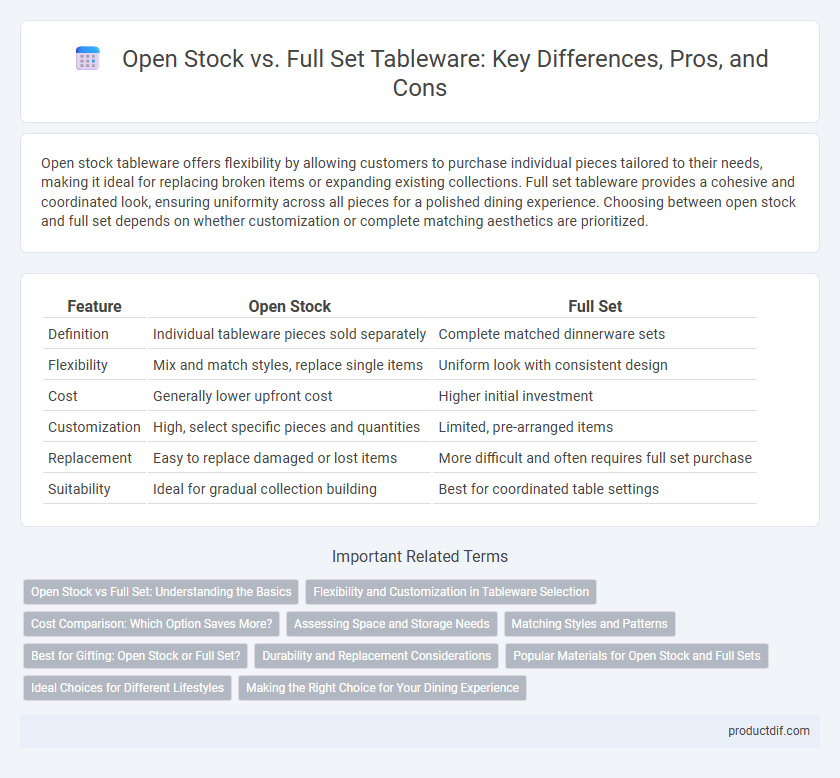Open stock tableware offers flexibility by allowing customers to purchase individual pieces tailored to their needs, making it ideal for replacing broken items or expanding existing collections. Full set tableware provides a cohesive and coordinated look, ensuring uniformity across all pieces for a polished dining experience. Choosing between open stock and full set depends on whether customization or complete matching aesthetics are prioritized.
Table of Comparison
| Feature | Open Stock | Full Set |
|---|---|---|
| Definition | Individual tableware pieces sold separately | Complete matched dinnerware sets |
| Flexibility | Mix and match styles, replace single items | Uniform look with consistent design |
| Cost | Generally lower upfront cost | Higher initial investment |
| Customization | High, select specific pieces and quantities | Limited, pre-arranged items |
| Replacement | Easy to replace damaged or lost items | More difficult and often requires full set purchase |
| Suitability | Ideal for gradual collection building | Best for coordinated table settings |
Open Stock vs Full Set: Understanding the Basics
Open stock tableware allows customers to purchase individual pieces, offering flexibility to mix and match styles, replace broken items, or build customized collections over time. Full set options provide a cohesive, pre-arranged collection designed for consistent presentation, typically including plates, bowls, and utensils to serve a defined number of settings. Understanding the benefits of open stock versus full set helps consumers and businesses optimize their tableware investments based on usage patterns and aesthetic preferences.
Flexibility and Customization in Tableware Selection
Open stock tableware offers exceptional flexibility by allowing users to purchase individual pieces tailored to specific needs, enabling easy replacement and mix-and-match customization. Full set options provide consistent design and uniformity across all pieces but can limit personalization and adaptability for varying table settings or occasions. Choosing open stock supports evolving styles and practical adjustments, while full sets cater to cohesive aesthetics and standardized use.
Cost Comparison: Which Option Saves More?
Open stock tableware allows purchasing individual pieces, offering flexibility and cost savings by replacing only what is needed, reducing waste and upfront investment. Full sets often come with a higher initial cost but provide uniformity and convenience for large scale needs or consistent presentation. For businesses or homes seeking budget control and customization, open stock typically saves more money over time.
Assessing Space and Storage Needs
Open stock tableware allows flexible purchasing of individual pieces, optimizing storage by selecting only needed items, contrasting with full sets that require substantial space due to uniform quantity. Assessing kitchen cabinet dimensions and drawer capacities is crucial when deciding between open stock and full sets to ensure efficient use of storage areas. Prioritizing stackable and space-saving designs in open stock options further enhances organization and accessibility.
Matching Styles and Patterns
Open stock tableware allows for mixing and matching individual pieces from different patterns and styles, giving flexibility to create a personalized table setting. Full set tableware provides a cohesive look with perfectly matched styles and patterns designed to complement each other seamlessly. Selecting open stock is ideal for those who want variety, while full sets cater to those prioritizing uniformity and coordinated aesthetics.
Best for Gifting: Open Stock or Full Set?
Open stock tableware offers customizable gifting options, allowing recipients to choose individual pieces that match their style or replace specific items. Full sets provide a cohesive and coordinated presentation, ideal for those seeking a complete dining experience in one gift. Selecting between open stock and full set depends on whether the gift recipient prefers personalization or a unified tableware collection.
Durability and Replacement Considerations
Open stock tableware offers enhanced durability by allowing users to replace individual pieces without discarding an entire set, reducing long-term costs and waste. Full sets provide uniformity but may require complete replacement if key items break, increasing expenses over time. Selecting open stock options supports sustainable use by extending the lifespan of tableware through targeted replacements.
Popular Materials for Open Stock and Full Sets
Popular materials for open stock tableware include porcelain, stoneware, and melamine, valued for their durability and ease of replacement. Full sets often feature coordinated collections in bone china or earthenware, providing a cohesive look for formal dining. Both options offer versatility, but open stock allows customization through individual pieces, while full sets ensure uniformity in style and finish.
Ideal Choices for Different Lifestyles
Open stock tableware offers customizable options ideal for individuals seeking to replace specific pieces or mix styles, promoting personalization and cost-efficiency. Full sets provide cohesive designs perfect for those valuing uniformity and convenience, especially in busy households where matching patterns enhance aesthetic consistency. Choosing between open stock and full sets depends on lifestyle needs--flexibility and variety suit evolving tastes, while full sets support effortless, unified table settings.
Making the Right Choice for Your Dining Experience
Selecting between open stock and full set tableware depends on your dining needs and style preferences. Open stock allows flexibility to mix and match pieces for personalized settings, while full sets offer cohesive design and convenience for uniform table presentation. Evaluate your usage frequency and desired aesthetics to make the right choice for a functional and visually appealing dining experience.
Open Stock vs Full Set Infographic

 productdif.com
productdif.com